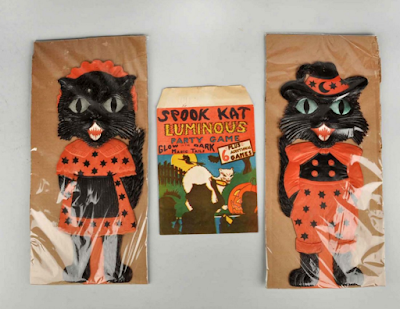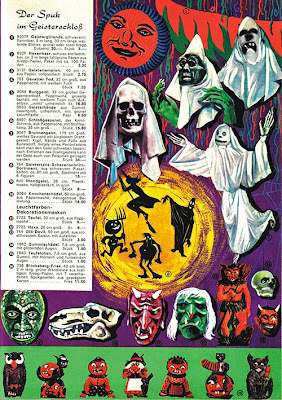Diecut Bubble?

Sane Halloween Observer
Following (without direct reference to buyers or sellers) are some interesting examples of what I call the vagaries of vintage prices:
ONE: It was surprising that one lot (from a well-known auction house) sold extremely weak in early September (just weeks before the big holiday). Ten German diecuts together with two product packages sold as a lot for $550 --- roughly $50 each. However if you assume the Dancing Skeleton envelope is firmly worth a suggested guidebook price of $325, then from the remaining sale price the embossed pieces would have cost about $25 each.
Lot of 13 items (above) sold for $550 plus auction fees.
To complicate matters the savvy buyer/seller began turning these around to a different venue the very day the auction hammer fell. During the weeks leading up to Halloween, the diecuts sold separately for roughly around $100+ each. This introduces 2 questions --- How rare is an item that is churning between venues? And what is the actual value when an item is selling to different audiences who may have different perceptions of the market?

TWO: Like any category, some items will likely remain more elusive than others.... but it seems imperative that long-time collectors begin to provide better evidence of their research regarding production and availability dates of products available to both U.S./Canadian markets as well as across the ocean. It appears now that much of the existing stock was cross-marketed to various holiday celebrations inside and outside the borders of the country of manufacturer, and for more years than previously believed?
For example, the vintage witch design (shown above) sold during 2015 as a pair for $1400. One guidebook references the characters from this set of seven as rare with availability only during the 1920s.

However, a German-language catalog page (above) shows these (as well as one well-known devil) seemingly available within the country of origin as recent as 1968-1970!?! See this entry: Seven Spooks in Narrenfibel 1968 / 1970. What is the larger story here, and how does this effect true rarity and price?

The German diecut (at top of the collage) has lately been re-photographed by the buyer and viewable on a site touting the esteem of high-value vintage Halloween collectibles. For this diecut it was a quick and interesting turn of events, something that actually happens more frequently (within all categories) than an average onlooker might guess. Having seen this diecut before in other collections --- what is the actual story of this item? Considering what was shown in examples one and two, what was its production and availability history?

While I know this entry is likely raising more questions than it is offering answers, I believe these are important to consider --- if for no other reason than to have as mental references when reading the price (often sensational) or language (often hyperbole) attached to any vintage piece, until such time as better records are offered and/or evident.





